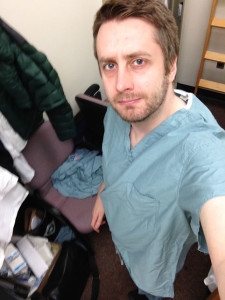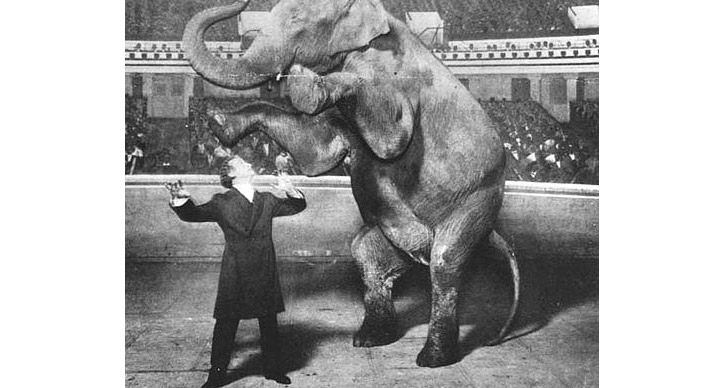Artist Spotlight: Theater maker Rob Drummond
Editor’s note: Theater maker Rob Drummond’s Bullet Catch was part of UMS’s 2014-15 season. He returned this season for an extended educational residency, a collaborative effort between the University of Michigan’s Medical Arts program and UMS’s educational programs at U-M. As part of the residency, Rob is researching for a new play related to medicine. We asked him to write about his adventures in Ann Arbor.
November 6
I left the flat this morning at 4:30 am. I have not slept. And now the border control guy is doing his job. That’s all he’s doing. His job. Don’t blame him. Don’t get angry. That will only make things worse. I’m sitting in ‘the room.’ I’ve seen other people brought here but they were (borderline racism alert) not white, middle class, English speaking Brits like me. There’s an Asian woman sitting near me who looks on the brink of tears. As people in ‘the room’ often look. As I most likely look. I have tried to explain what I am doing over here.
Well, one thing I’m doing is running theater workshops for medical students.
The border control guy stares at me for around five seconds, like a dog trying to lip-read. And then replies …
Why?
Hmmm. How to explain my practice of cross-disciplinary, immersive artwork in one ‘get you across the border safely’ soundbite. Apparently, it can’t be done. So now I’m in ‘the room.’ And he’s on the phone to Mary Roeder, UMS Manager of Community Engagement, whose number I have got from the laptop that currently has 6% battery left. The laptop that has all the information about my stay here on it. And my adapter is in my suitcase. If that battery dies, then so do I. A bone-fide ticking clock drama on my hands here.
The longest three minutes of my life pass by before Mary calls back. She seemed to say the right things, and before I know it Officer Crocker was escorting me out of ‘the room’ and back into the airport. I hate Officer Crocker. Not because he was just doing his job. But because he did it with such grim authority. He is everything, I think, that the arts are not. He is the reason I make art. The world needs less of him.
November 7

If America were a person, I’d recommend psychiatric help. This was my first thought upon walking into the stadium where one hundred and eight thousand people had gathered to watch college kids playing football. Pure theater. My second thought. I used to play rugby at a decent level for my college. I remember the time we had forty people show up to a game and spoke of it for years to come. Everything is bigger in America.
November 9
I got a look at the Kevorkian papers today. Incredible collection, and something I would not have been able to access without this residency. I didn’t realize Kevorkian was an artist as well as a doctor. As well as a murderer. But was he? Or did he just help desperate people to do something they couldn’t do themselves? His name is certainly whispered as that of some sort of a boogie-man figure, but reading through the letters of his patients, I couldn’t help but feel that he was doing some important work in a controversial way. He was certainly challenging the status quo. Challenging conventional notions of morality. And he certainly had confidence in his convictions. I couldn’t help but like him. But maybe I am romanticizing him. Much much more research is required before I can begin work on anything that is even remotely like Kevorkian, the Musical, as my fevered imagination had already titled the project I had, before today, never even considered working on.
In the afternoon I visit a patient presentation class, which plays out remarkably like a play. We are introduced to the main character, a real life patient, who reminds me slightly of Woody Allen, and then we are invited to re-visit his experience in being diagnosed with a mystery illness. I am trying my best to guess along with the students (incredibly intelligent, all) and, thanks to many many hours of watching medical dramas, I manage (in my head, I don’t dare raise my hand) to follow the case and even make some sensible assumptions. I am struck with an idea that I must speak to Joel Howell (U-M Professor ad doctor) about. Replacing an hour of lectures every term with a play which explores the medical and ethical dilemmas of a specific patient’s case. Sort of like this but more highly dramatized, using actors and performed in a theater (not that type). I need to stop having ideas for things I am not here specifically to work on.
In the evening my mind turns fully to the reason I am here. Interviewing medical students and doctors about their experiences. I am writing a play for the Royal Court Theatre in London, and I think Act Two will be a verbatim piece using the testimonies of said medics and, more specifically, the topic if delivering bad news. It fascinates me as a dramatist that these people spend so much time surrounded by death and yet seem so well-adjusted. Perhaps it is precisely because they spend so much time in and around the thing that the rest of us try to avoid that makes them so well-adjusted. Or perhaps they are not as well-adjusted as I think. As the interviews commence, I realize that it is a combination of the two. It also strikes me that perhaps medical students are the only group of people who think about death as much as artists do.
November 10
What I was finding hard to explain to Officer Crocker is that when I make a piece of theater, I often like to immerse myself in the world so that I can feel more authoritative when I write about it. I have trained as a magician (the show which originally brought me to Ann Arbor and started this whole crazy love affair), a wrestler, and a dancer for shows in the past, and now was the time to experience just a fraction of what medical students and doctors experience by accompanying Dr. Scally on trauma rounds.

I get up at half-past ridiculous and make my way to the hospital. Which is like a small city. Feeling deeply intimidated and scared, I change into a set of scrubs. You can probably see in the photo below the mixture of fear and tired I was experiencing at this point. And then, as if I had always been a part of the team, as if it was the most natural thing in the world, I accompany two doctors, a resident, and a student (I think I’ve got that right) on rounds. Confidentiality precludes my mentioning anything specific but suffice to say it was an eye opening experience, my major take away being the feeling that doctors absolutely have to develop a dark sense of humor to get them through the day. They have to.
November 12
I have done a few workshops by this point and something that has struck me is that there really is little difference between the artists and the medical students. Whether it be improvisation, writing, or performing, they all enter into it with the same vigor. Both groups offer up insightful and interesting suggestions. Both are equally uncomfortable standing silently in front of the rest of the group. All the workshops are more or less effortless to deliver because the students are so…bright. One group came up with a brilliant play that was set at the top of the Empire State Building during its construction. Four workers on a metal beam, as in that famous photograph. In one-and-a-half hours together we fleshed out this idea, made it real. When I left, one of the students was sitting and writing in the hall. She said she had started writing the play we had just created. I was pleased. I went out and ate some food. Drank far too much beer (Apparently the Hop Cat loves a British accent). And when I came home again around half eleven…She was still there. Still writing.
It might have been the beer, but that made me choke up a little.
November 16
Really getting to know and like the people who are showing me such great hospitality while I am here. The interviews are going so well — getting so much incredible material. The students and doctors alike are amazingly open, to the extent that I am starting to feel guilty about milking them for their stories of misery. However, what has been coming out of this is the understanding that they are anything but miserable despite the fact they are surrounded by so much of it. They are doing a good thing with their lives. The delivery of bad information is not enjoyable, but the fact that they take part in such vital conversations, perhaps the most vital you will ever have, fills many of them with a kind of satisfaction. It’s a privilege. That’s a phrase I’m hearing a lot. It’s a privilege to be trusted with such a sensitive moment in a person’s life. To be sharing something real. Again, a massive similarity between artists and doctors presents itself. We are both looking for something real. We are both searching for truth. In many different ways.
November 17
I had a rip-roaring time at a trivia night last night (the only thing we won was an over-sized Miller Lite T-shirt which my wife is now wearing as a night-gown), but I was a good boy and didn’t drink too much as I knew I had to be up for another set of rounds, this time internal medicine, with Dr. Fine. As the picture below might suggest, this set of rounds did not require me to wear scrubs, so I felt a little less awkward. Again, I was welcomed into the fold as if I was just another medical student. The patients, I realized, didn’t have a clue that I wasn’t some world leading expert in something, which actually made me relax a little bit. Little did they know I was actually a nervous, anxiety ridden, socially awkward wreck. But actually, from the interviews I have conducted, I have come to realize that this is the normal way for a student to feel in a hospital.

These rounds are different. Less immediate danger. But more emotional somehow as the patients stories can be delved into in more detail. I come out feeling my respect for doctors deepen still. Dr. Fine genuinely cares about his patients. He cares not only about making them physically better but making sure they are emotionally cared for.
November 18
Another session with the Kevorkian papers is followed by my last workshop. We seem to save the best for last as together we come up with a concept for a play and create another world in an hour-and-a-half. This is the story of a young offender in prison. The twist is we never see her face. We only hear her voice and we learn about her through the visitors she receives. A really genuinely exciting concept created from nothing and fleshed out with characters, a plot line, and a question we collectively try to answer. What Price Truth? I’ve capitalized that question because it also works as the title. What is the truth worth? Should the girl lie for a reduced sentence or keep telling the truth and get life? Should we tell the difficult truths or lie for an easier life?
This cuts to the heart of the play I am working on for the Court. How do you tell someone they are going to die? Do you sugar coat or do you tell them the cold hard truth? Is it ever right to withhold information from a patient to spare their feelings? What Price Truth?

A good way to end my stay.
November 19
I left Michigan yesterday evening. And now I’m going through customs at Glasg-. Oh. I’m through. He barely looked at my passport. The joys of returning to your home country as a national. On my way though, I see a passenger has been taken aside (we don’t have the budget for a whole room apparently) and is being questioned. He doesn’t speak much English – he’s dark-skinned, possibly Indian, I’m not sure. The difference? This time the border control people are smiling. Joking with him. Trying to put him at ease. We’ll get this sorted. Don’t worry.
You see that Officer Crocker. That’s how you do it.
Rob Drummond is a writer, performer and director from Glasgow. His theater credits include Sixteen (Arches Theatre Festival), Hunter (National Theatre of Scotland and Frantic Assembly), Mr Write (Tron Theatre and the National Theatre of Scotland), and Rob Drummond: Wrestling (The Arches, winner of a Vital Spark Award), among others.
When Bullets Flew

Photo: Rob Drummond in Bullet Catch. Bullet Catch is at the Arthur Miller Theatre in Ann Arbor on January 7-12, 2014. Photo courtesy of the artist.
Reviewing Bullet Catch for the New York Times a few months ago, Charles Isherwood noted that while the sound of gunfire onstage is hardly unusual, the shots in Bullet Catch “are more unsettling than most.” That’s because they’re real, because they’re fired by a volunteer from the audience, and because they’re aimed straight at the head of performer and creator Rob Drummond.
Drummond’s 75-minute show re-creates a stage trick that took off in Europe in the 17th century and remained popular well into the 19th—and on more than one occasion proved lethal. Drummond claims he’s exploring the idea of free will as an “illusion” by re-enacting the perilous stunt—and inviting an audience volunteer to join him—but Isherwood finds the whole thing “in terrible taste,” even though Drummond gives audiences a chance to leave just before the climactic “bullet catch.”
Performance trailer
I suspect Isherwood would have been none too happy with the 19th-century American stage, where actors repeatedly pulled out—and used—real firearms in yet another chapter in this country’s long and tumultuous love affair with guns. Before its renovation in the 1990s, my own favorite theater, the Fulton Opera House in Lancaster, Pennsylvania, built in 1852, was thought to bear the scar of at least one bullet on its proscenium arch—the result of a misfire by Buffalo Bill during one of his six appearances there between 1873 and 1882.

Buffalo Bill.
William F. Cody—aka Buffalo Bill—was perhaps the most famous practitioner of the so-called American “border drama,” but he had plenty of company. Go to a show in the late-19th century in one of the nearly 4,000 theaters that stretched across the nation, and you were likely to stumble on a play about Davy Crockett or Jesse James or Daniel Boone, about pioneers or rangers, miners or sharpshooters or Mormons with “one hundred wives.” The real American frontier may have been in its death throes, but the stage version was alive and well.
Audiences poured into theaters to see real “marksmen,” “sharpshooters,” “wing shots,” “rifle shots,” and “dead shots” shatter glass balls and tempt disaster. In his prairie dramas and Wild West shows, Buffalo Bill shot apples and potatoes from women’s heads and cigars from men’s mouths, often holding his rifle upside-down or firing backwards with the help of a mirror.
Cody seldom misfired, but others weren’t so lucky. On November 30, 1882, Frank Ivers Frayne killed his fiancee in front of a crowd of 2,300 inside Cincinnati’s Coliseum Theater.
Famed for the spectacular shooting stunts he wove into the plots of his plays (most of them set in the American West), Frayne was an expert marksman, capable of extinguishing a candle with a bullet, shooting a pipe out of a ranch hand’s mouth, firing a bullet through the rope of an innocent man about to be hanged, and shooting two guns simultaneously in two different directions, so that bullets shattered objects on either side of the stage—all tricks he performed during his 20-odd years of touring the country’s theaters. He taught his wife and two kids to shoot as well, and they often performed with him.
The backward shot
In his most daring stunt, “the backward shot,” Frayne blasted an apple off his wife’s head while propping his rifle on his shoulder and focusing in a mirror. (According to one account, the bullet sometimes not only pierced the apple but also triggered another rifle aimed at a plate suspended inches above Frayne’s head.) Ads reassured nervous theatergoers that the “backward shot” looked more dangerous than it was, because the actress wore a chain mail skullcap, and the apple rested on a six-inch hat.
After his wife’s death in 1880—apparently from natural causes—Frayne hired a 23-year-old actress named Annie Von Behren to be his assistant in the stunt, and the two became engaged.
At a matinee performance on Thanksgiving afternoon in Cincinnati on November 30, 1882, Frayne set up his backward shot as usual and pulled the trigger. A sudden burst of smoke enveloped his head, burning Frayne’s face and neck. The unexpected blast shoved the barrel of his rifle down by a few lethal inches, and with 2,300 people looking on, a bullet shattered Annie’s forehead. “My God! My God! What have I done?” Frayne bellowed as he rushed to her side. The curtain came down, and backstage, with Frayne moaning beside her, Annie Von Behren died. Frayne was charged with manslaughter but exonerated. He resumed performing in early 1883, some four weeks after the accident, but in a nod to safety he abandoned his most dangerous stunts. He continued to tour until his death in 1891.
Neither Frayne nor his promoters seemed to mind capitalizing on the tragedy. Announcements for his shows invariably mentioned Annie’s death, with graphic accounts of Frayne’s rushing to her and swooning over her corpse. The actor, papers reported, “is broken down with uncontrollable grief.” It was all theater—as is, I sometimes think, our contemporary fascination with guns and the tragedies they spawn.
And as I hope Bullet Catch will be. Asked if either the audience or he himself is in actual danger during the show, Rob Drummoned has said, “Them, no. Me, yes.” I have a sneaking suspicion I may be one of those audience members who heads for the exit when given the chance.
Interested to know Leslie’s post-performance response? Come back to UMS Lobby’s “People are Talking” section after the performance.
5 Curiosities about Bullet Catch

Photo: Rob Drummond in Bullet Catch. Photo courtesy of the artist.
A stunt so dangerous that Houdini refused even to attempt it, the magic trick known as the Bullet Catch has claimed the lives of at least 12 illusionists, assistants, and spectators since its conception in 1613. Director Rub Drummond explores the history of the Bullet Catch, including the true story of William Henderson, who died in 1912 attempting the infamous trick. Bullet Catch is (at Arthur Miller Theatre January 7-12), and in preparation, we’ve dug up 5 curious facts about the trick.
Behind the Scenes with Rob Drummond
This post is a part of a series of playlists curated by artists, UMS Staff, and community. Check out more music here.

Photo: Harry Houdini (1874-1926) vanishing Jennie, the elephant, performing at the Hippodrome, New York. Photo by White Studio.
We asked Rob Drummond, director, writer, and performer of Bullet Catch (at Arthur Miller Theatre January 7-12) to put together a playlist for us, maybe something having to do with magic. A stunt so dangerous that Houdini refused even to attempt it, the magic trick known as the Bullet Catch has claimed the lives of at least 12 illusionists, assistants, and spectators since its conception in 1613. Drummond explores the history of the Bullet Catch, including the true story of William Henderson, who died in 1912 attempting the infamous trick.
Rob Drummond: This is admittedly an unusual and eclectic mix but then again I don’t trust anyone who only likes one type of music just as I don’t trust someone who only likes action movies or only likes pizza. Common People is my favourite song of all time – I won a talent competition singing it when I was fifteen. Killing in the Name Of is one to lose yourself to in a disco at three in the morning. Al Wilson’s The Snake tells a great story and is really an allegory for domestic abuse, which is hard to pull off in a finger snapping big band style. Elvis is just Elvis. Sinatra, ditto. Magic by ‘The Boss’ is the exit music for Bullet Catch and It’s a Kind of Magic used to be the opening song in the much cheesier version of the show from circa 2008. Cee Lo Green’s joyously incongruous use of the most satisfying of expletive phrases is just a fun fun song. My twin niece and nephews used to sing along with the clean version (Forget You). And lastly, a song from my past as Francie and Josie, the greatest Scottish comedy double act of all time (available on YouTube), sing about the quaint single track transport system enjoyed by my Grandparents and upon which I now travel every day.
“Glasgow Underground” by Francie and Josie:
What did you think about this playlist? Share your thoughts or song suggestions in the comments below.


